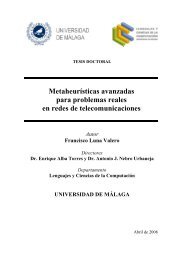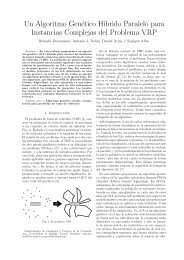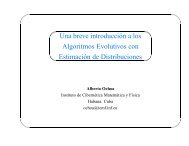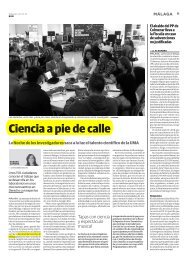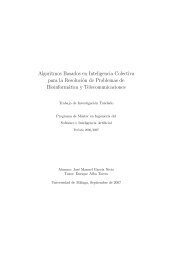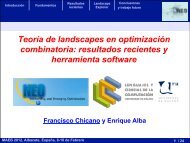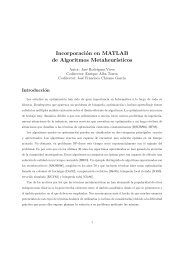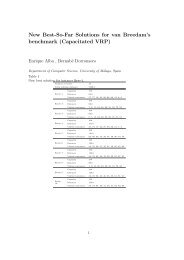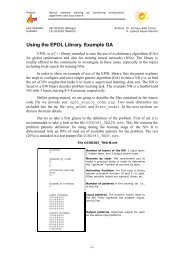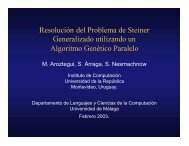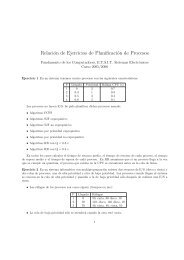Comparing Metaheuristic Algorithms for Error Detection in ... - NEO
Comparing Metaheuristic Algorithms for Error Detection in ... - NEO
Comparing Metaheuristic Algorithms for Error Detection in ... - NEO
Create successful ePaper yourself
Turn your PDF publications into a flip-book with our unique Google optimized e-Paper software.
Table 2. Parameters of the algorithms<br />
Beam Search Random Search<br />
Parameter Value Parameter Value<br />
Queue limit (k) 10 Path length 350<br />
GeGA algorithm<br />
Parameter Value<br />
M<strong>in</strong>imum path size 10<br />
Maximum path size 350<br />
Population size 50<br />
Selection operator Tournament (5 <strong>in</strong>dividuals)<br />
Crossover probability 0.7<br />
Mutation probability 0.01<br />
Elitism true (5 <strong>in</strong>dividuals)<br />
Respawn after 5 generations with same population average fitness<br />
or 50 generations without improvement <strong>in</strong> best fitness<br />
GeGAMO algorithm<br />
Parameter Value<br />
M<strong>in</strong>imum path size 10<br />
Maximum path size 50<br />
Population size 50<br />
Selection operator Tournament (3 <strong>in</strong>dividuals)<br />
Crossover probability 0.7<br />
Mutation probability 0.01<br />
Elitism true (3 <strong>in</strong>dividuals)<br />
Memory operator frequency 10<br />
Memory operator size 25<br />
Respawn after 5 generations with same population average fitness<br />
or 60 generations without improvement <strong>in</strong> best fitness<br />
PSO algorithm ACOhg algorithm<br />
Parameter Value Parameter Value<br />
Number of Particles 10 Length of ant paths 300<br />
M<strong>in</strong>imum path size 10 Colony size 5<br />
Maximum path size 350 Pheromone power (α) 1<br />
Iterations Until Perturbation 5 Heuristic power (β) 2<br />
Initial <strong>in</strong>ertia 1.2 Evaporation rate (ρ) 0.2<br />
F<strong>in</strong>al <strong>in</strong>ertia 0.6 Stored solutions (ι) 10<br />
Inertia change factor 0.99 Stage length (σs) 3<br />
SA algorithm<br />
Parameter Value<br />
Path size 350<br />
Initial temperature 10<br />
Temperature decay rate (α) 0.9<br />
Iterations without improvement 50<br />
makes them suitable <strong>for</strong> non-complete search algorithms, because although they<br />
cannot prove correctness of a model, they can be used to prove the <strong>in</strong>correctness<br />
and help the programmer to understand and fix the properties violations.<br />
The results obta<strong>in</strong>ed from the experiments can be analyzed <strong>in</strong> several ways.<br />
We will discuss the results on the success of each algorithm <strong>in</strong> f<strong>in</strong>d<strong>in</strong>g the errors,<br />
measured as the hit rate, and the length of the error trail lead<strong>in</strong>g to the error.<br />
Determ<strong>in</strong>istic algorithms always explore the states <strong>in</strong> the same order, which<br />
means that only one execution per problem <strong>in</strong>stance is needed. The results of<br />
stochastic search algorithms, however, could change at each execution. For this<br />
reason, each stochastic algorithm was executed 100 times per problem <strong>in</strong>stance.






